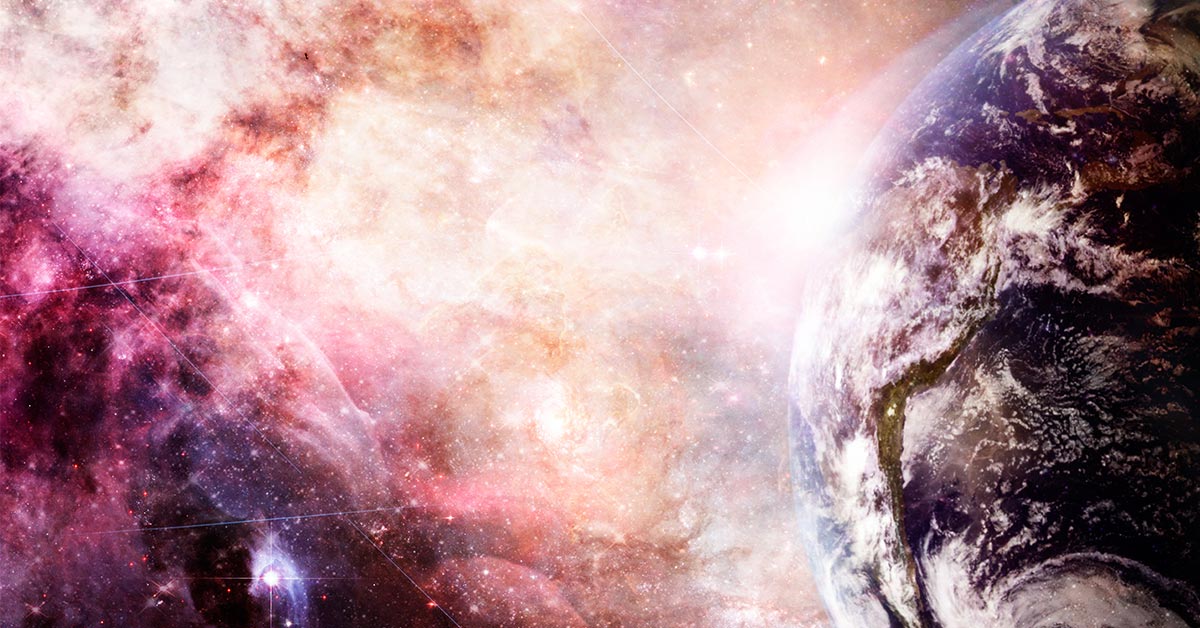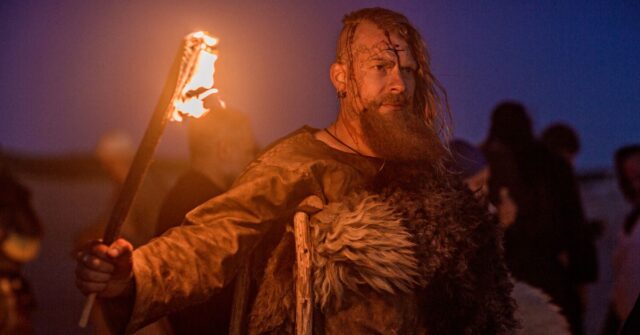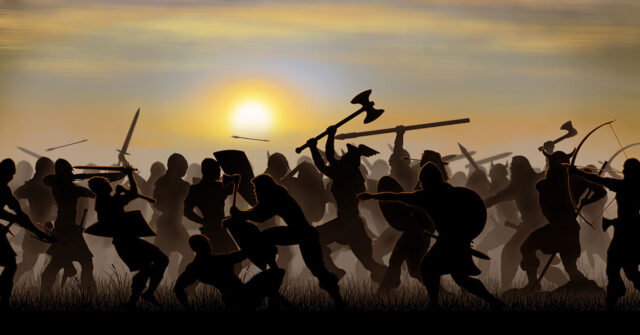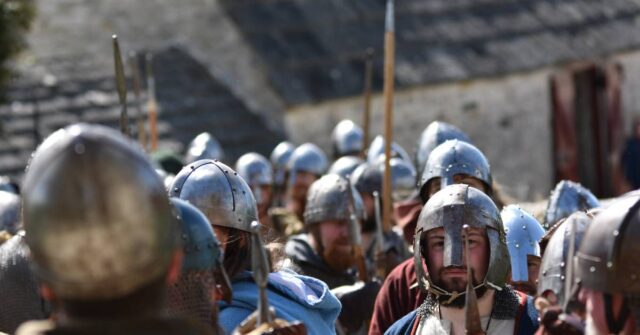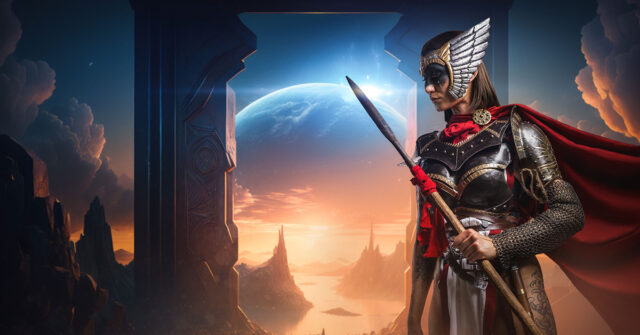In Norse mythology, the cosmos is a complex and intricate tapestry of realms and beings, woven together by the threads of fate and the World Tree, Yggdrasil.
This article will explore the creation of the Norse cosmos and the significance of Yggdrasil, as well as the many deities, creatures, and realms that populate this fascinating mythological universe.
Introduction to Norse Mythology
Norse mythology is a rich and complex belief system that originated in the Nordic countries during the Viking Age. It encompasses a vast array of gods, goddesses, heroes, and creatures that have shaped the cultural and spiritual identity of the Norse people.
Read on as we explore the origins and influences of Norse mythology, as well as the key deities and mythological creatures that inhabit the Norse cosmos.
Origins and Influences
Norse mythology is the pre-Christian belief system of the Nordic peoples, primarily those from modern-day Denmark, Norway, Sweden, Iceland, and the Faroe Islands. It is deeply rooted in oral tradition and shares many elements with the mythologies of other Germanic and Indo-European cultures.
Its stories were passed down through the generations by poets, storytellers, and historians, and were eventually recorded in works such as the Poetic Edda and the Prose Edda in the 13th century.
Key Deities and Mythological Creatures
The Norse pantheon is divided into two main groups: the Aesir and the Vanir. The Aesir, led by the all-powerful Odin, are often associated with warfare, wisdom, and rulership, while the Vanir, a more nature-oriented group of gods, are connected with fertility, prosperity, and magic.
In addition to gods and goddesses, the Norse cosmos is inhabited by an array of creatures such as giants, dwarves, elves, and various other beings, each playing a unique role in the intricate web of Norse mythology.

The Norse Cosmos: Nine Realms and Their Inhabitants
The Norse cosmos is divided into Nine Realms, each with its own unique inhabitants and characteristics. These realms are interconnected by Yggdrasil, the great World Tree that serves as the axis of the cosmos.
In this section, we will explore each of the Nine Realms and the various beings that call them home.
Ásgard: Home of the Aesir Gods
Ásgard is the realm of the Aesir gods, ruled by Odin and his wife, Frigg. The gods reside in magnificent halls, the most famous being Valhalla, where Odin gathers the souls of fallen warriors to prepare them for the final battle of Ragnarok.
Ásgard is connected to the human realm, Midgard, by the rainbow bridge, Bifrost, guarded by the god Heimdall.
Vanaheim: Home of the Vanir Gods
Vanaheim is the homeland of the Vanir gods, a more agrarian and peaceful group of deities focused on fertility, prosperity, and the natural world.
Notable Vanir gods include Freyja, goddess of love and fertility; her brother Freyr, god of agriculture and fertility; and their father Njord, god of the sea and wealth.
Jotunheim: Home of the Giants
Jotunheim is the realm of the giants, beings often in conflict with the gods. It is a harsh and inhospitable land of mountains, glaciers, and deep forests.
Giants in Norse mythology are not simply large humans; they come in various forms and sizes, with some possessing incredible strength and magical abilities.
Despite their frequent battles with the gods, the giants are also intertwined with the deities through marriages and alliances, highlighting the complex and sometimes contradictory relationships within the Norse cosmos.
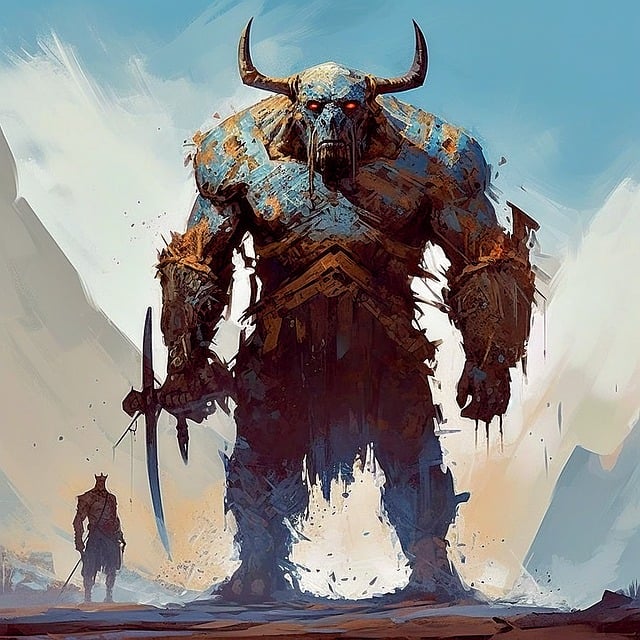
Midgard: Home of Humans
Midgard, or “Middle Earth,” is the realm inhabited by humans. It is situated in the center of the Norse cosmos and is surrounded by an impassable ocean inhabited by the sea serpent Jormungandr.
Midgard is connected to Ásgard by the Bifrost bridge, symbolizing the link between gods and humans in Norse mythology.
Nidavellir: Home of the Dwarves
Nidavellir is the subterranean realm of the dwarves, master craftsmen, and miners who are responsible for forging many of the gods’ most powerful and magical weapons and artifacts.
The dwarves are known for their incredible skill and cunning, often striking deals with the gods that come with unexpected consequences.
Alfheim: Home of the Light Elves
Alfheim is the realm of the light elves, beautiful and luminous beings who are said to inspire art, music, and poetry. They are associated with the god Freyr, who rules over them and ensures their prosperity.
The light elves live in harmony with nature, and their realm is a place of peace and enchantment.
Svartalfheim: Home of the Dark Elves
Svartalfheim is the domain of the dark elves, also known as the dökkálfar or svartálfar. They are mysterious and elusive beings, associated with the darker aspects of magic and the underground world.
The dark elves are often seen as malevolent, but their true nature and intentions remain ambiguous.
Helheim: Realm of the Dead
Helheim is the realm of the dead, ruled by the goddess Hel, the daughter of Loki. It is the final resting place for those who died of old age, sickness, or any means other than in battle.
Helheim is a cold and dreary realm, contrasting with the glorious afterlife promised to fallen warriors in Valhalla.
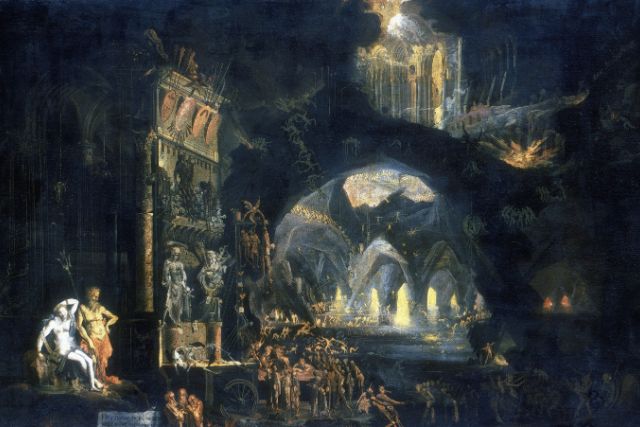
Muspelheim: Land of Fire
Muspelheim is a primordial realm of fire and heat, inhabited by the fire giants and ruled by the fearsome Surt. It is a place of chaos and destruction, and it is said that at Ragnarok, Surt will lead his fire giants to battle against the gods, setting the world ablaze.
Niflheim: Land of Ice and Mist
Niflheim is the primordial realm of ice, cold, and mist. It is a desolate and inhospitable land, and at its heart lies the well Hvergelmir, the source of eleven rivers that flow throughout the Norse cosmos.
Niflheim is the antithesis of Muspelheim, representing the constant struggle between the forces of creation and destruction in Norse mythology.
Creation of the Norse Cosmos
The Norse cosmos was born from the void of Ginnungagap, a place where the forces of fire and ice came together to form the building blocks of life. The creation story is filled with dramatic events, from the birth of the first giant Ymir to the emergence of the gods and the shaping of the Nine Realms.
In this section, we will delve into the fascinating process that led to the formation of the Norse cosmos and its intricate web of interconnected realms and beings.
Ginnungagap: The Great Void
In the beginning, there was Ginnungagap, a vast and empty void that separated the realms of fire and ice. Over time, the heat from Muspelheim and the cold from Niflheim began to meet in Ginnungagap, creating the conditions for life to emerge.
Muspelheim and Niflheim: The First Worlds
The two primordial realms, Muspelheim and Niflheim, were the first worlds to form in the Norse cosmos. Their opposing forces of fire and ice played a crucial role in the creation of life.
As the heat from Muspelheim met the cold of Niflheim in Ginnungagap, the resulting condensation and melting ice formed the first living beings.
Ymir: The First Giant
Ymir, the first giant, was born from the meeting of fire and ice in Ginnungagap. Ymir was a hermaphroditic being, capable of producing offspring on his own.
As he slept, more giants were born from the sweat of his body, and thus the race of giants began to populate the cosmos.
Audhumla: The Primordial Cow
Alongside Ymir, the primordial cow Audhumla was also formed from the meeting of fire and ice. Audhumla provided sustenance for Ymir, as he fed on her milk, while she herself was nourished by licking the salty ice blocks in Ginnungagap.
Her licking revealed the first god, Buri, from whom the lineage of the Aesir gods would descend.
Birth of the Aesir Gods
From Buri’s lineage, the Aesir gods Odin, Vili, and Ve were born. These gods represented a new order in the Norse cosmos, one that would challenge the giants for dominance and ultimately shape the world as we know it.
The Cosmic Struggle and the Death of Ymir
In a struggle for supremacy, Odin and his brothers slew Ymir and used his body to create the world. From Ymir’s flesh, they formed the earth; from his blood, the seas; from his bones, the mountains; from his hair, the trees; and from his skull, the sky.
The gods also used Ymir’s eyebrows to create a barrier around Midgard, protecting humans from the giants.
Formation of the World and the Nine Realms
After the death of Ymir, the gods established the Nine Realms, each with its own unique inhabitants and characteristics. These realms were interconnected by the great World Tree Yggdrasil, which served as the axis of the cosmos and supported the intricate web of life within the Norse universe.
Yggdrasil: The World Tree
Yggdrasil, the World Tree, is a central symbol in Norse mythology that connects and sustains the Nine Realms. This immense ash tree embodies the interconnectedness of all things in the Norse cosmos and reflects the cyclical nature of time and existence.
In this section, we will examine the structure and significance of Yggdrasil and its role in Norse mythology.
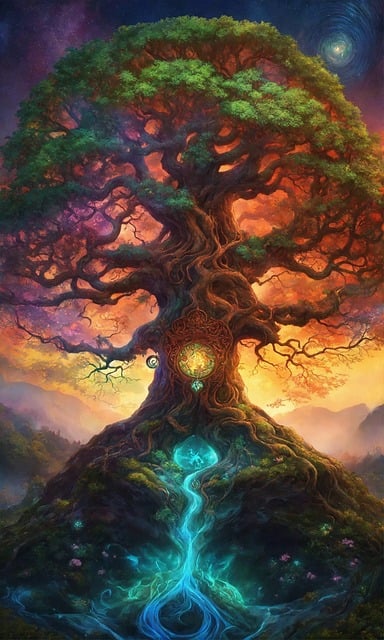
Structure and Significance
Yggdrasil is an immense ash tree, with branches that reach into the heavens and roots that stretch deep into the earth. It connects and sustains the Nine Realms, symbolizing the interconnectedness of all things in the Norse cosmos.
The tree is also a reflection of the Norse belief in the cyclical nature of time and the eternal cycle of life, death, and rebirth.
Three Major Roots and Their Wells
Yggdrasil has three major roots, each reaching into a different realm and anchored by a sacred well. The first root extends into Asgard and is connected to the Well of Urd, where the Norns, female beings who govern fate, reside.
The second root reaches Jotunheim and is associated with the Well of Mimir, a source of wisdom guarded by the wise giant Mimir. The third root delves into Niflheim and is connected to the well of Hvergelmir, the source of the primordial rivers.
Inhabitants of Yggdrasil
Various creatures inhabit Yggdrasil, each playing a role in maintaining the balance of the cosmos or symbolizing aspects of the Norse belief system.
Among these creatures are the eagle perched atop the tree, the squirrel Ratatoskr that carries messages between the eagle and the serpent Nidhogg gnawing at the tree’s roots, and the four stags Dainn, Dvalinn, Duneyrr, and Durathror that graze on the tree’s foliage.
These creatures represent the forces of life, communication, conflict, and the cyclical nature of existence.
The Role of Yggdrasil in Norse Mythology
Yggdrasil plays a vital role in Norse mythology, connecting the realms and providing a framework for the stories and characters within the mythological universe.
The tree is a central symbol in many Norse myths, serving as a meeting place for the gods, a battleground for epic conflicts, and the backdrop for the ultimate cosmic event, Ragnarok.
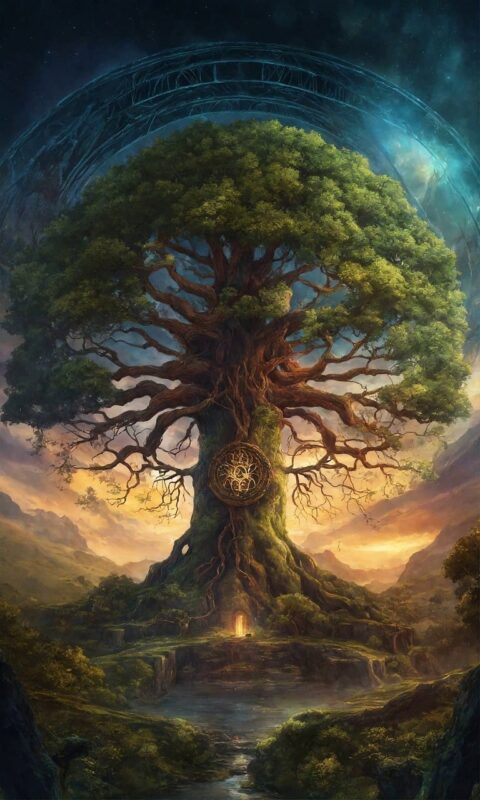
The Fate of the Norse Cosmos: Ragnarok
Ragnarok, often referred to as the twilight of the gods, is the cataclysmic event that ultimately leads to the destruction and rebirth of the Norse cosmos.
This apocalyptic battle between gods, giants, and other mythological beings marks the end of the current cosmic cycle and ushers in a new era of renewal.
In this section, we will explore the signs, omens, and events that lead up to Ragnarok and the aftermath of this world-shattering conflict.
Signs and Omens
Ragnarok, the twilight of the gods and the end of the world is an essential part of Norse mythology. It is a series of catastrophic events, marked by various signs and omens, such as the death of the god Balder, the chaining and subsequent escape of the wolf Fenrir, and a series of natural disasters, including the Fimbulwinter, a great winter that lasts for three years.
The Final Battle
At Ragnarok, the gods, giants, and other mythological beings will engage in a final, apocalyptic battle that will result in the destruction of the world.
Odin will face the monstrous wolf Fenrir, Thor will confront the serpent Jormungandr, and the fire giant Surt will lead his forces against the gods. Many gods and beings will perish in this cataclysmic conflict, marking the end of the current cosmic cycle.
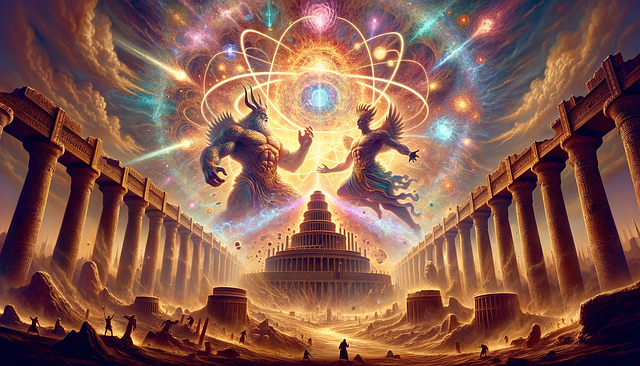
Aftermath and Renewal
Despite the destruction wrought by Ragnarok, the Norse cosmos is not destined for eternal oblivion. A new world will rise from the ashes of the old, with a few surviving gods and a new generation of humans repopulating the earth.
This cycle of destruction and renewal reflects the Norse belief in the eternal and cyclical nature of existence.
Conclusion: Norse Cosmos and Modern Interpretations
Norse mythology has left an indelible mark on the world of art, literature, and popular culture. Its influence can be seen in countless modern adaptations and reinterpretations, ensuring that the stories and characters of the Norse cosmos will continue to captivate audiences for generations to come.
In this concluding section, we will discuss the legacy of Norse mythology in art and literature, as well as its impact on modern adaptations and influences.
Legacy in Art and Literature
Norse mythology has left a lasting impact on art, literature, and popular culture, with its compelling stories and vivid imagery continuing to inspire generations of artists, writers, and scholars.
From the intricate carvings on Viking ships to the epic sagas of the medieval period, the Norse cosmos has been immortalized in countless artistic and literary works.
Modern Adaptations and Influences
In recent years, Norse mythology has experienced a resurgence in popularity, thanks in part to modern adaptations and reinterpretations in books, films, television shows, and video games.
From Marvel’s Thor and the TV series Vikings to the bestselling novel “American Gods” by Neil Gaiman, the Norse cosmos continues to captivate audiences worldwide, ensuring that its rich and fascinating stories will endure for generations to come.

